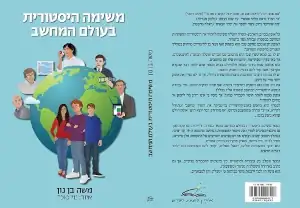List of subjects explained in the Israeli bestseller "Historical Mission in the Computers World" (partial list)
1.
The Difference Engine
A machine that knew to compute complicated calculations mechanically, before the computer was invented.
The closest machine in comparation to computers, that was not based on electricity.
2.
Turing Machine
An analytical model that was developed by Alan Turing.
The model made it possible to prove for a speific calculation that we are able to build a machine to calculate it using a list of commands (algorithm), without actually building the machine.
3.
Von-Neumann Architecture
An architecture that physically implemented the Turing machine model, and turned it into an actual computer.
The modern computers are still based on it even today.
4.
Assembly Language
Low-level language for processors.
Was in a common use, before the development of high-level languages.
5.
C Language
High-level language that became popular and exchanged the wide use of Assembly.
Made it easier for programmers to develop applications. It was used for writing the Unix operating system.
6.
Operating System
The most basic program in the computer. Acts as an interface between the user and the computer.
Examples of today's most common operating systems: Windows, Android, MacOS and Linux.
7.
8086 Processor
The processor whose entry into the market led to a meteoric rise in the adoption of personal computers due to its being cheap and suitable for creating computers in a size that was considered small at the time.
During the development of smartphones, the 8086 processor series was abandoned in favor of ARM processors, which consume much lower electrical power.
8.
Arpanet Network
A military network that was used to transfer data between computer networks in remote locations and had formed the basis for the establishment of the Internet.
The innovation in the Arpanet network was the ability to link between networks from different types by using a uniform protocol, regardless of the distance between the endpoints.
9.
The USB standard
Today's popular port that replaced the old, bulky ports on the computer's motherboard.
The news it brought is the standardization of the motherboard's connections, including charging capacity and saving space in the case.
10.
Computer's Virus
Malicious code that causes the computer to operate in a different way than the user expects, and can thereby cause a destruction of the computer, a destruction of the data on it or a theft of information.
In addition to viruses, there are other dangers today for stealing information online such as phishing scams and social engineering.
11.
USB Flash Drive (Disk-On-Key)
Modern digital media that was developed in Israel and allows to store a large amount of information and carry it anywhere.
This is done using the USB port to allow any computer to read the information on the portable storage without the need of a unique adapter.
12.
The Open Source Community
A community that enshrines the use of free software and the accessibility to information, software and programming knowledge - espcially to underprivileged populations.
The most popular free software is the Linux Operating System, which is used on smart cards and functions as the basis of the Android Operating System.
13.
Arduino Board
A smart electronic board that replaced the classic FPGA boards and was counted as the breakthrough of cheap smart boards that allow programming in high-level languages.
Later, smart cards with an ARM processor that constituted a full computer, were also a breakthrough for the development of smart homes and smart embedded systems.
| דירוג תגית ממוצע: | 5 (מתוך 3 דירוגים סה"כ) |
About the bestseller: Historical Mission In Computers World
Mentioned inventors - Historical Mission In Computers World
